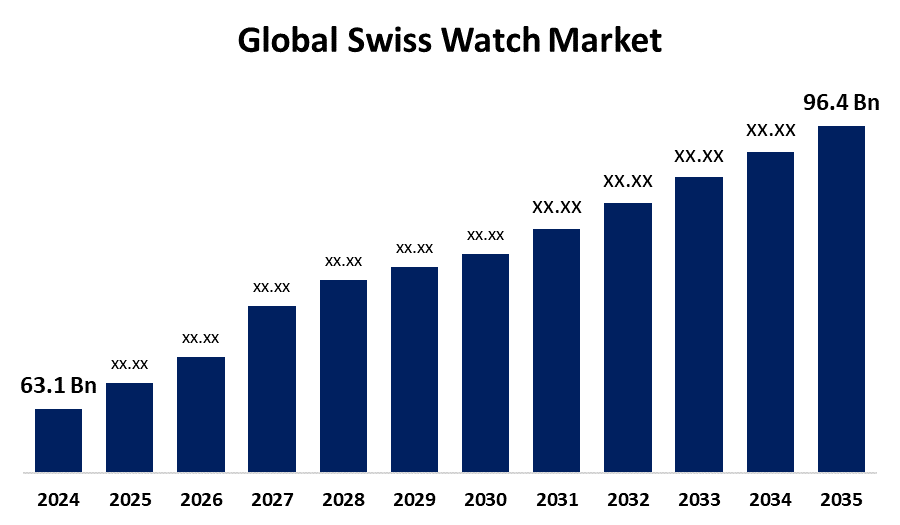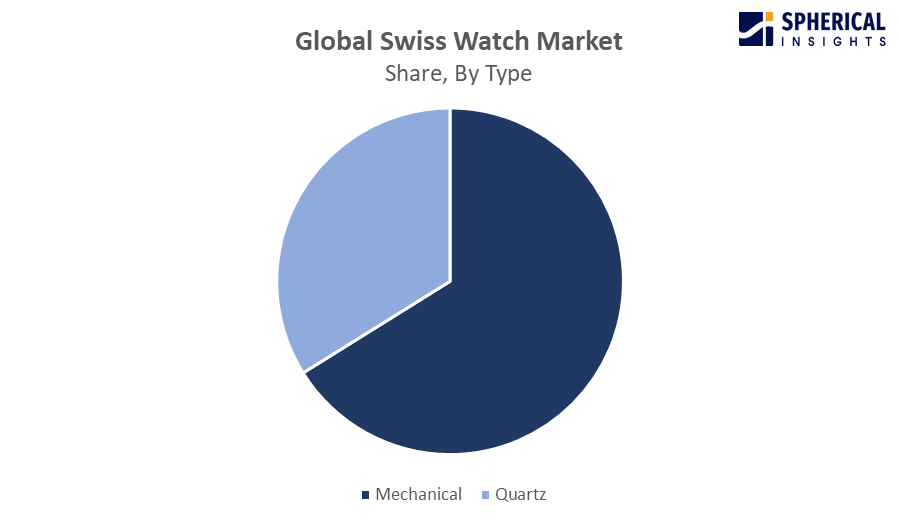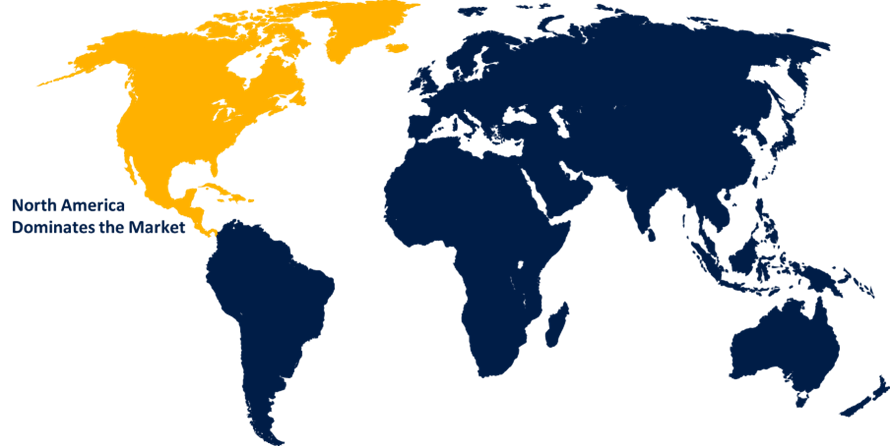Global Swiss Watch Market Size, Share, and COVID-19 Impact Analysis, By Type (Mechanical and Quartz), By Distribution Channel (Online and Offline), By Region (North America, Europe, Asia-Pacific, Latin America, Middle East, and Africa), Analysis and Forecast 2025 - 2035
Industry: Consumer GoodsGlobal Swiss Watch Market Size Insights Forecasts to 2035
- The Global Swiss Watch Market Size Was Estimated at USD 63.1 Billion in 2024
- The Market Size is Expected to Grow at a CAGR of around 3.93% from 2025 to 2035
- The Worldwide Swiss Watch Market Size is Expected to Reach USD 96.4 Billion by 2035
- Asia Pacific is expected to Grow the fastest during the forecast period.

Get more details on this report -
According to a Research Report Published by Spherical Insights and Consulting, The Global Swiss Watch Market Size was valued at approximately USD 63.1 Billion in 2024 and is projected to Grow from USD 65.6 Billion in 2025 to around USD 96.4 Billion by 2035 with a compound annual growth rate (CAGR) of 3.93% from 2025 to 2035. The global Swiss watch sector is primarily driven by a strong brand history, quality craftsmanship, demand growth in emerging nations, consumer appetite for luxury, technological advances with smart features, and growing duty-free and online retail channels.
Global Swiss Watch Market Forecast and Revenue Outlook
- 2024 Market Size: USD 63.1 Billion
- 2035 Projected Market Size: USD 96.4 Billion
- CAGR (2025-2035): 3.93%
- North America: Largest market in 2024
- Asia Pacific: Fastest growing market
Market Overview
The swiss watch market involves the sale of swiss-made watches that are characterized by precision, luxury, craftsmanship and tradition. This segment of watches includes smart, quartz, and mechanical watches, and is sold in high-end and luxury consumer segments throughout the world. The Swiss watch market keeps on expanding because of its legacy and reputation for craftsmanship and precision, which helps keep globally exclusive pricing. Luxury watches are trendy status symbols and lifestyle markers due to greater wealth in developing economies, particularly in the Middle East and Asia-Pacific region. Reach is enhanced through strategic marketing, retail proliferation, and access to international luxury markets. While mechanical watches are still critical, the brands are now embracing digital marketing, limited runs, and innovative styling to attract younger consumers and to support long-term growth. The Swiss watch industry has experienced a significant increase by combining time-honoured craftsmanship with modern technology, resulting in timepieces that are both exclusive and technologically advanced. By incorporating advanced technologies like GPS tracking, fitness monitoring, and heart rate tracking into their products, already-established brands such as TAG Heuer, Montblanc, and Garmin have enticed consumers seeking precision, versatility, and prestige. Swatch Group and Omega's 2022 MoonSwatch partnership serves as an example of how iconic design and cost may be combined to appeal to a wider range of consumers. These partnerships, which emphasize innovation, originality, and legacy, enable Swiss watchmakers to interact with devoted collectors while drawing in younger, aspirational consumers, thereby enhancing the industry's accessibility, relevance, and long-term demand worldwide.
Key Market Insights
- North America is expected to account for the largest share in the Swiss Watch Market during the forecast period.
- In terms of type, the mechanical segment is projected to lead the Swiss Watch Market throughout the forecast period
- In terms of distribution channel, the offline segment captured the largest portion of the market
Swiss Watch Market Trends
- Increasing demand in both established and emerging markets for mechanical watches with a legacy and a sense of luxury.
- Collaborations and limited editions, which combine exclusivity and innovation, are becoming more and more popular.
- Incorporating intelligent features like internet connectivity, fitness monitoring, and GPS.
- Increasing retail footprint in luxury hubs in the Middle East and Asia-Pacific.
- A greater emphasis on sustainability, personalisation, and digital involvement to draw in younger audiences.
Report Coverage
This research report categorizes the swiss watch market based on various segments and regions, forecasts revenue growth, and analyzes trends in each submarket. The report analyzes the key growth drivers, opportunities, and challenges influencing the swiss watch market. Recent market developments and competitive strategies, such as expansion, type launch, development, partnership, merger, and acquisition, have been included to draw the competitive landscape in the market. The report strategically identifies and profiles the key market players and analyzes their core competencies in each sub-segment of the swiss watch market.
Global Swiss Watch Market Report Coverage
| Report Coverage | Details |
|---|---|
| Base Year: | 2024 |
| Market Size in 2024: | USD 63.1 Billion |
| Forecast Period: | 2025-2035 |
| Forecast Period CAGR 2025-2035 : | 3.93% |
| 2035 Value Projection: | USD 96.4 Billion |
| Historical Data for: | 2020-2023 |
| No. of Pages: | 154 |
| Tables, Charts & Figures: | 130 |
| Segments covered: | By Type, By Distribution Channel and COVID-19 Impact Analysis |
| Companies covered:: | Rolex, Patek Philippe, Audemars Piguet, The Swatch Group, Richemont, LVMH Moët Hennessy Louis Vuitton, Breitling, Chopard, Hublot, Zenith, and Others |
| Pitfalls & Challenges: | COVID-19 Empact, Challenges, Future, Growth, & Analysis |
Get more details on this report -
Driving factors:
Design and technological innovation, brand legacy, and growing worldwide prosperity are the main elements propelling the Swiss watch market.
The Swiss watch industry is driven by a continuous cycle of innovation in materials, movements, and design, ensuring durability, precision, and style. Manufacturers are increasingly using cutting-edge materials such as carbon fibre, titanium, and ceramic to enhance comfort, reduce weight, and increase strength. Continuous advancements in mechanical movements strengthen Switzerland's reputation for precision and reliability in the high-end of the market. The combination of traditional workmanship with modern design and collaboration with independent or luxury brands facilitates exclusivity and innovation to entice both novice and experienced collectors searching for unique, high-end, and stylish watches.
Restraining Factor:
Accessibility to the Swiss watch market is limited by high prices and maintenance costs.
Swiss watches are too expensive to produce. High-end materials, advanced technology, skilled labour, and increasing production costs are all contributing factors. Other challenges to ownership costs include expensive maintenance and repair services for complex mechanical movements, once the purchase has been made. This has kept Swiss watches as nearly exclusively owned by affluent consumers, due to the purchase and operation costs involved. There may be limited public adoption of Swiss watches due to the expenses associated with Swiss watches, as high prices remain a key barrier to entering the market on a larger scale or attracting additional customers.
Market Segmentation
The global Swiss Watch market is divided into type and distribution channel.
Global Swiss Watch Market, By type:
Why is the mechanical segment expected to generate the highest revenue, with approximately 81.4% in 2024 for the global Swiss Watch (CBCT) market during the forecast period?
The mechanical segment led the swiss watch market, generating the largest revenue share. Their associations with art, quality, and history. Their hand-made finishes and multiple complications deem them luxury investments, enticing collectors and enthusiasts around the globe. Their leading market position is further enabled by restricted volume and brand longevity, compounded by thoughts of mechanical watches as symbols of respectability.

Get more details on this report -
The quartz segment in the swiss watch market is expected to grow at the fastest CAGR over the forecast period. Motivated by their precision, reduced maintenance needs, and affordability. They draw a wider range of customers, including those looking for inexpensive Swiss timepieces and younger consumers. Further bolstering consistent development in this sector is the growing adoption of fashion-forward designs, women's markets, and casual luxury lines.
Global Swiss Watch Market, By Distribution Channel:
What factors make the offline segment dominate in terms of market share, with 87.5% approximately, during the forecast period in the global Swiss Watch (CBCT) market?
The offline segment held the largest market share in the swiss watch market. The luxury market is relying on in-person shopping experiences to allow clients to see artistry, receive individualized service, and solidify relationships of trust with approved retailers. With flagship boutiques, high-end department stores, and exclusive events all reinforcing brand image and exclusivity, there is a genuine preference for purchasing in person over buying online.
The online segment in the swiss watch market is expected to grow at the fastest CAGR over the forecast period. prompted by enhanced customer security when spending big sums online, the expansion of brand-owned e-commerce sites, and advancements of digital and mobile authentication. Marketers can reach younger, adept, luxury customers through global reach, visually immersive product imagery, and online consultations to meet demand across countries.
Regional Segment Analysis of the Global Swiss Watch Market
- North America (U.S., Canada, Mexico)
- Europe (Germany, France, U.K., Italy, Spain, Rest of Europe)
- Asia-Pacific (China, Japan, India, Rest of APAC)
- South America (Brazil and the Rest of South America)
- The Middle East and Africa (UAE, South Africa, Rest of MEA)
North America Swiss Watch Market Trends

Get more details on this report -
What factors contribute to the North America region holding the largest share of the global Swiss Watch market during the forecast period?
The market for Swiss watches in North America is flourishing, fueled by affluent consumers, a well-established collecting enthusiasm and respect for fine craft. In a well-developed luxury industry with flagship stores, authorized retailers, luxury chains, offering a strong retail channel, and enjoyment of mechanical timepieces and loyalty to heritage brands, North America’s luxury industry is solid. Major brands such as Patek Philippe, Omega, and Rolex are staples, whereas newcomers utilize exclusive boutiques and e-commerce to engage consumers. As luxury smart watch demand continues, it creates opportunity, sustains growth, and promotes Swiss watchmakers in this flourishing market.
Why does the United States lead the North American Swiss Watch market?
Demonstrating significant growth underpinned by stable economic conditions, high per capita luxury spending, and a vibrant premium watch gifting culture. Both practical and investment value fuel consumer interest, with mechanical, limited-edition, and custom versions doing especially well. The nation is a major growth engine for Swiss watch sales, and this position is further reinforced by aggressive marketing campaigns, celebrity endorsements, and special retail experiences.
Asia Pacific Swiss Watch Market Trends
How is the Asia Pacific region expected to be the fastest-growing Swiss Watch market with the fastest growth rate?
Spurred by the quick rise in luxury demand, especially in China, Hong Kong, and Japan, which are major markets for Swiss watch retail and re-export. Demand is driven by growing disposable incomes, a burgeoning affluent class, and the cultural link of Swiss watches with success in the workplace and prestige. Additionally, flagship boutiques and premium retail collaborations are helping brands penetrate growing markets like Southeast Asia and India.
Why is the Swiss Watch market growing in Europe?
Switzerland, Germany, the UK, and France are the world's leading demand for luxury timepieces, emphasizing that Europe continues to be a key market for Swiss timepieces. Switzerland still dominates the Swiss watchmaking industry as the center of Swiss watchmaking, producing currently more than half of the luxury timepieces produced. The region is a prominent opportunity in part because European countries accept the status, history and experience of Swiss firms. Swiss manufacturers are also embracing greener processes because eco-friendly, renewable premium products are trending in demand.
Competitive Analysis:
The report offers the appropriate analysis of the key organizations/companies involved within the global swiss watch market, along with a comparative evaluation primarily based on their type of offering, business overviews, geographic presence, enterprise strategies, segment market share, and SWOT analysis. The report also provides an elaborate analysis focusing on the current news and developments of the companies, which includes type development, innovations, joint ventures, partnerships, mergers & acquisitions, strategic alliances, and others. This allows for the evaluation of the overall competition within the market.
Worldwide Top Key Players in The Swiss Watch Market Include
- Rolex
- Patek Philippe
- Audemars Piguet
- The Swatch Group
- Richemont
- LVMH Moët Hennessy Louis Vuitton
- Breitling
- Chopard
- Hublot
- Zenith
- Others
Key Target Audience
- Market Players
- Investors
- End-users
- Government Authorities
- Consulting and Research Firm
- Venture capitalists
- Value-Added Resellers (VARs)
Recent development
- In September 2025, TAG Heuer’s Carbon Hairspring (TH-Carbonspring) TAG Heuer will debut a carbon-based hairspring called TH-Carbonspring, offering enhanced shock resistance, antimagnetism, and better performance. It will be used in two limited edition models, including the Monaco Flyback Chronograph TH-Carbonspring
- In May 2025, the Solana blockchain and Swiss luxury watchmaker Franck Muller collaborated to launch a new limited-edition collection. There are only 1,111 pieces in the series, making it extremely unique. The timepieces combine cutting-edge digital technology with classic Swiss workmanship to provide both flair and modern appeal. The cost of each watch is 20,000 Swiss francs, or around $24,356 USD.
- In September 2024, Swiss brand Norqain launched the Independence Skeleton Chrono, powered by the new 8K Manufacture Calibre developed with Manufacture AMT. Featuring a skeleton design, 62-hour reserve, and limited production, it reflects Swiss watchmaking innovation and exclusivity.
Market Segment
This study forecasts revenue at the global, regional, and country levels from 2020 to 2035. Spherical Insights has segmented the swiss watch market based on the following segments:
Global Swiss Watch Market, By Type
- Mechanical
- Quartz
Global Swiss Watch Market, By Distribution Channel
- Online
- Offline
Global Swiss Watch Market, By Regional Analysis
- North America
- US
- Canada
- Mexico
- Europe
- Germany
- UK
- France
- Italy
- Spain
- Russia
- Rest of Europe
- Asia Pacific
- China
- Japan
- India
- South Korea
- Australia
- Rest of Asia Pacific
- South America
- Brazil
- Argentina
- Rest of South America
- Middle East & Africa
- UAE
- Saudi Arabia
- Qatar
- South Africa
- Rest of the Middle East & Africa
Frequently Asked Questions (FAQ)
-
1. What is the CAGR of the Swiss Watch market over the forecast period?The global Swiss Watch market is projected to expand at a CAGR of 3.93% during the forecast period.
-
2. What is the market size of the Swiss Watch market?The global Swiss Watch market size is expected to grow from USD 63.1 billion in 2024 to USD 96.4 billion by 2035, at a CAGR 3.93% of during the forecast period 2025-2035.
-
3. Which region holds the largest share of the Swiss Watch market?North America is anticipated to hold the largest share of the Swiss Watch market over the predicted timeframe.
-
4. Who are the top 10 companies operating in the global Swiss Watch market?Rolex, Patek Philippe, Audemars Piguet, The Swatch Group, Richemont, LVMH Moët Hennessy Louis Vuitton, Breitling, Chopard, Hublot, and Zenith.
-
5. What factors are driving the growth of the Swiss Watch market?Consumer demand for high craftsmanship, strong brand legacy, and growing global prosperity all contribute to the growth of the Swiss watch market. Demand is further increased across a range of demographics by innovations in materials and motions, growing retail in emerging regions, digital involvement, and exclusive limited editions.
-
6. What are the market trends in the Swiss Watch market?Eco-friendly packaging and sustainable materials like recycled steel, bio-plastics, and ethical gold are being used more and more by Swiss brands. Limited-edition and ultra-luxury models are still in demand. Demand for mechanical timepieces is increasing, particularly among younger buyers. Traditional versions are starting to incorporate smartwatch functions. Partnerships increase the attractiveness and reach of a brand.
-
7. What are the main challenges restricting wider adoption of the Swiss Watch market?High pricing that restricts accessibility, growing labour and production expenses in Switzerland, and costly maintenance for intricate mechanical movements are some of the issues facing the Swiss watch industry. Wider acceptance is further constrained by competition from smartwatches and changing consumer tastes, especially among younger and more budget-conscious consumers globally.
Need help to buy this report?